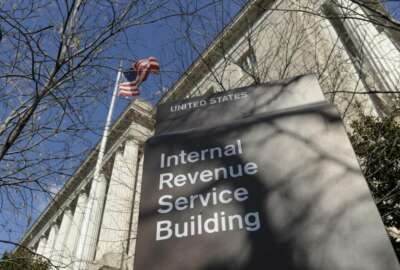

The IRS is getting its shot to rebuild its workforce and bring its IT into the 21st century, after more than a decade of belt-tightening.
Best listening experience is on Chrome, Firefox or Safari. Subscribe to Federal Drive’s daily audio interviews on Apple Podcasts or PodcastOne.
The IRS is getting its shot to rebuild its workforce and bring its IT into the 21st century, after more than a decade of belt-tightening.
The House on Friday passed the Inflation Reduction Act, which now heads to President Joe Biden’s desk. The $740 billion spending bill allows a broad swath of federal agencies to staff up over the next decade, but none will go through the kind of transformation the IRS will face.
The bill gives the IRS $80 billion over the next 10 years, with more than half that money going toward its tax enforcement operations. But the IRS expects the money will help it bring on the next generation of its workforce and make long-deferred investments in its IT that will improve taxpayer services.
A Congressional Budget Office report last year found the IRS would more than double its workforce under this spending plan. Much of that hiring, however, is needed just to keep pace with the agency’s rate of attrition. The agency recently told Congress it had 33,000 fewer employees in 2020 than it did a decade ago.
The $80 billion in multi-year spending marks a major turning point for the IRS and its operations, but the agency won’t be able to go from famine to feast overnight.
Former IRS Commissioner John Koskinen said in an interview that he expects the IRS’s spending in the first year will be “relatively modest,” compared to what the agency will be able to fund in the following years.
National Treasury Employees Union President Tony Reardon said the IRS’ current challenge in hiring 10,000 additional employees by the end of next year demonstrates that bringing a new generation of IRS employees onboard won’t be easy.
“I don’t think anyone should assume that you can simply snap your fingers and add, in a really short period of time, tens of thousands of employees. I think we’ve learned that over the last few months, in the submission processing and accounts management hiring efforts, that that is certainly true,” Reardon said.
Ron Sanders, a former chief human resources officer at the IRS, said the agency will need to start by reinvesting in its HR office, or work with outside contractors to hire at the levels it will see in the coming years.
“The IRS has not hired at this level — basically any level — for many, many years. That’s a skill that atrophies,” Sanders said.
Koskinen said he saw the atrophy of those hiring capabilities during his tenure, when the IRS had trouble bringing on even a modest number of new employees.
“You can’t hire anybody unless your human resources process and structure is up and running. A few times, when we had a chance to hire 50 people, we discovered that when you cut HR by 40%, it’s hard to do even a relatively small number,” Koskinen said. “The IRS has been hiring more people recently, and that has to reflect that HR has been rebuilt to some extent. But to really move forward across the board for taxpayer services, information technology and enforcement, that’s going to take a little time to get up and running.”
The Inflation Reduction Act gives the IRS an opportunity to reinvent itself over the coming years, but the final version doesn’t include everything the agency could have hoped for.
The Senate stripped a provision out of the final bill that would have given critical pay authority to as many as 500 IRS employees.
Koskinen said the IRS during his tenure used this authority to bring IT and cybersecurity professionals on board quickly, and pay them a higher salary than what the General Schedule pay scale would allow.
“Where the problem gets to be difficult is when you’re talking about people with very specialized skills and experience. That was where the bulk of the previous streamlined critical pay work went,” Koskinen said.
The IRS, in the FY 2022 omnibus spending bill, received direct hire authority to bring on thousands of employees to answer phones and process tax returns.
The IRS, even with streamlined critical pay authority, can’t compete with the private sector on salary, but it can soften the blow for in-demand hires looking to join government service.
“It was helpful then back when I was at IRS, and it would be helpful today, I think, to tell many of those recruits from the private sector, ‘We are paying you as much as the law allows. You’re getting paid as much as the Vice President of the United States,'” Sanders said.
The IRS didn’t get greater direct hiring authority or streamlined critical pay authority in the final bill, but the Office of Personnel Management is able to offer these workforce tools to the IRS on its own.
“OPM can and should, with alacrity, give IRS direct hire authority, based purely on critical need. If this is not a ‘critical need,’ as envisioned by the direct hire statutes, nothing beats that test,” Sanders said.
Reardon said the IRS chief human capital office needs to make full use of its recruiting and retention bonus authority, and must also bring on new hires more quickly. He said it currently takes about 65-75 days to onboard new hires.
“We are still seeing that the IRS is losing candidates who accept an offer, but then drop out before the background and suitability checks are complete,” Reardon said.
The hiring surge the IRS will oversee in the coming years will no doubt be daunting, but other agencies have done it before.
When the Bush administration created the Transportation Security Agency in 2001, former DHS Secretary James Loy developed a comprehensive hiring process that brought thousands of new employees onboard in a relatively short period of time.
“The IRS could learn from TSA, and yes, they will likely have to outsource a lot of that capability, because there are very few places in government that have this organic skill, and those that do are probably going to end up using it to hire under the infrastructure bill,” Sanders said.
Sanders, who also previously served as associate director of national intelligence and chief human capital officer at the Office of the Director of National Intelligence, said the intelligence community also went through a significant hiring surge immediately after the Sept. 11, 2001 attacks.
“There is expertise, both in terms of the process itself, setting up a mechanism to recruit, screen and onboard lots of employees. And there is expertise in achieving these kinds of numbers,” Sanders said. “If I were to give them advice, I would tell IRS, ‘Go seek them out, the federal agencies that have done this, the contractors that helped them do this,’ because they’re going to need it.”
The next wave of IRS employees won’t just be filling the positions of previous generations. Sanders said the IRS needs to fill “hybrid” jobs that require traditional audit and accounting skills, as well as data analysis skills that command high salaries in the private sector.
“These new [revenue agents] and [revenue officers] need to be amateur data scientists. And the IRS needs its own bevy of data scientists on top of that. That’s another specialty that I think is relatively new, and I’m not sure IRS has very many of them. If they do, they’ve used in-house employees and re-titled them, because they sure as heck haven’t been doing a lot of hiring,” Sanders said.
The spending bill will also allow the IRS to reinvest in training — a budget line that has seen severe cuts over the years.
Reardon said that training in recent years has been one of the first things to cut in the IRS budget. That, in turn, has hurt the agency’s ability to retain workers.
“What I’ve actually heard is that people sometimes feel like they are not properly trained and prepared to do the job. And so what happens then is they get bad evaluations, or they just feel like they’re not capable of doing the job, because they’re not adequately trained. And so what do they do? They leave,” he said.
Reardon said too many IRS employees quit in their first year on the job, because they felt they weren’t adequately prepared to do the job.
“Once you do add growing numbers of employees, you’ve got to make sure that they are prepared to take on the work. And it’s going to take time to be able to do that,” Reardon said.
He recalled that in 2013, the IRS cut its training budget by approximately 85%.
“You just can’t effectively run an organization like that. Like any organization, you need to know what your funding is going to be. What I think this money is going to really enable the IRS to do is plan long-term, to make sure that over the course of this 10-year period that this $80 billion covers, is to make certain that they’ve got the staffing that they need, that they get the training in place, that they get all their systems modernized, so that they are functioning,” Reardon said.
Sanders said its takes anywhere from 18 to 24 months, if not longer, to fully train a brand-new accountant to take on more complex enforcement cases.
“Those corporate tax offices are very well-resourced, and they have lots and lots and lots of expertise. IRS is going to have to match that with a developmental program second to none,” he said.
Koskinen said that even mid-career hires need a few years of experience in order to be brought up to speed on how the agency operates.
“Even somebody who has a lot of experience in tax law, coming into the agency still needs to get up to speed on how the process works, how audits are run, and what the internal systems look like,” he said.
Sanders said the current state of the IRS training program is a far cry from the late 1990s, when the IRS served as a career stepping-stone for many accountants and tax professionals.
“It used to be that almost every employee in every tax accounting firm [or] CPA who was worth anything had done some time in the IRS, particularly any in development. They literally got what amounted to a graduate degree in tax accountancy by working for the IRS,” Sanders said.
OPM has made it easier in recent years for mid-career tax professionals to become back to the IRS if they’d like, but Sanders said the agency will also need to bring new graduates into its hiring pipeline.
“That used to be a huge recruiting incentive for us in the IRS, to say, ‘Come work for us, we’ll give you a developmental program that nobody else is going to get. And if you stay with us, that’s fine. We’ll happily use you. But if you move on, that’s okay, too. You’ll have the skills and, frankly, an understanding of how IRS works,’’ Sanders said.
While the actual bucket of money reserved for taxpayer services is a relatively small percentage of the $80 billion total, Koskinen said a lot of the IT work is going to directly affect taxpayers.
“I think it’s very foreseeable and doable, with this additional funding, that at some point down the road, you should be, in effect, guaranteed that when you call, you’ll get somebody within three minutes or less. And if that happens, I think there should be a lot of happy taxpayers out there,” he said.
The multi-year funding will allow the IRS to achieve its long-term goal of having taxpayers interact with the agency online for the vast majority of services it offers.
“If you can get people off the phones who didn’t want to be there in the first place, who really would like to deal with the agency online, that by itself will make it easier to get ahold of people on the phone, if that’s the way you want to communicate,” Koskinen said.
The IT spending will also create a 360-degree view of a taxpayer’s interactions with the IRS. The agency currently has 60 disparate case management systems that don’t communicate with each other.
“If you’ve got two issues with the IRS, you used to sometimes call, get somebody to talk to you about the first issue, and then be told, ‘Wait, you’ve got to call back to get somebody else for the second issue,’ because the person talking about your first issue couldn’t see what the second issue was,” Koskinen said.
While some members of Congress have warned that the spending bill will lead to a surge of audits on households, Koskinen said the technology investments will allow the IRS to reduce the number of “no-change” audits the IRS conducts, in which the agency determines that no money is owed.
“They try to minimize that as much as they can. They track that number, because if somebody gets audited and there’s no change, that’s a waste of their time and the IRS’s time. The IRS is only anxious to do audits where people actually owe money, because it’s the way they’ve filed a return or not filed at all. So the idea that suddenly people who didn’t get audited and didn’t need to be audited are now going to get audited is just nuts,” he said.
The majority of Canada’s population lives within 185 miles of its border with the United States.
Source: Britannica
Copyright © 2025 Federal News Network. All rights reserved. This website is not intended for users located within the European Economic Area.
Jory Heckman is a reporter at Federal News Network covering U.S. Postal Service, IRS, big data and technology issues.
Follow @jheckmanWFED



